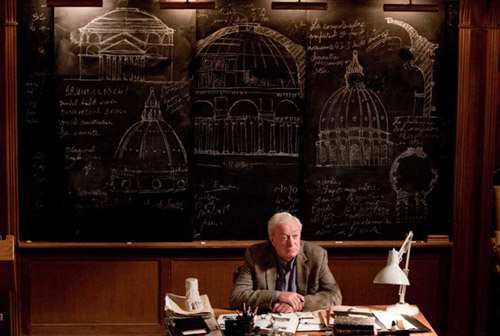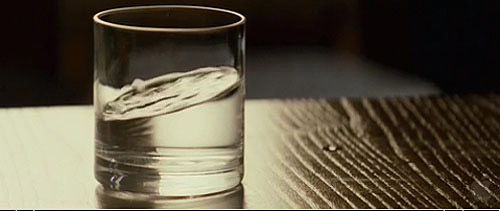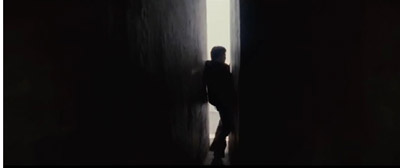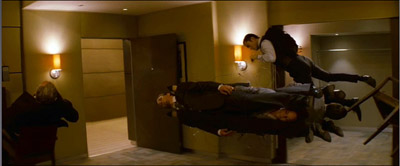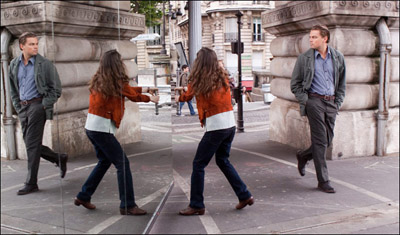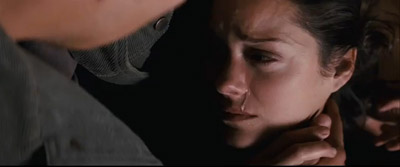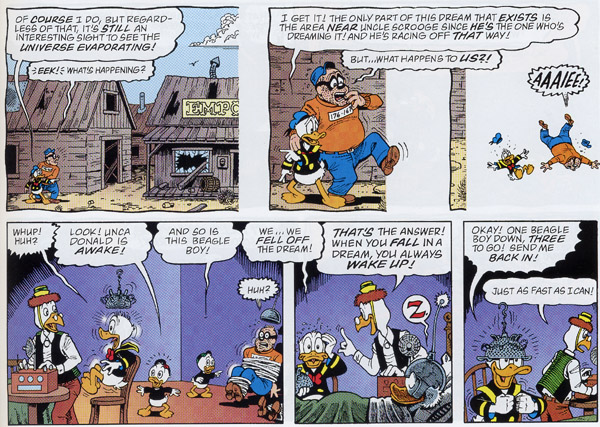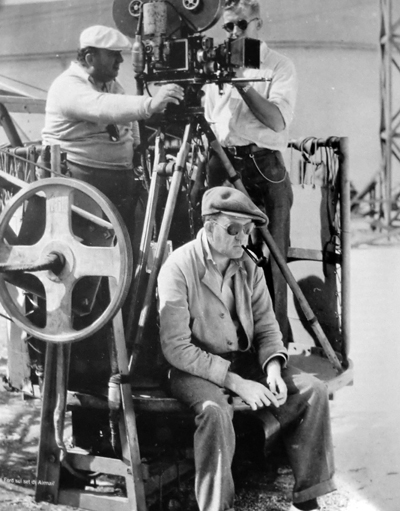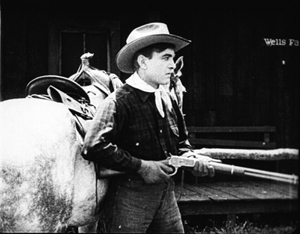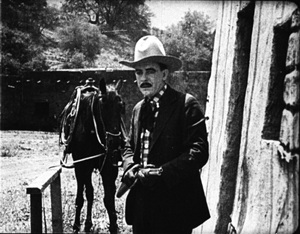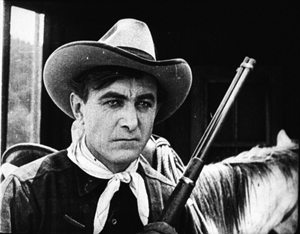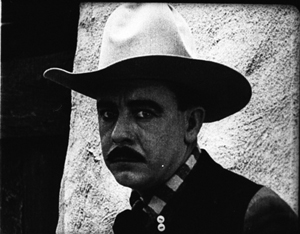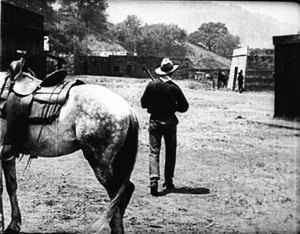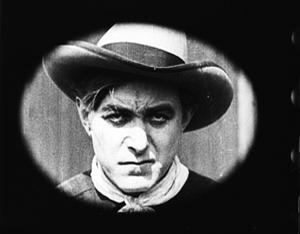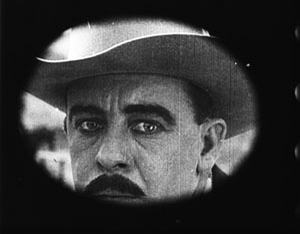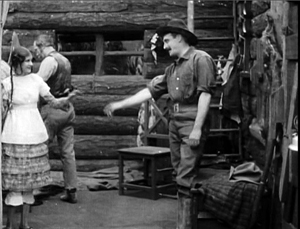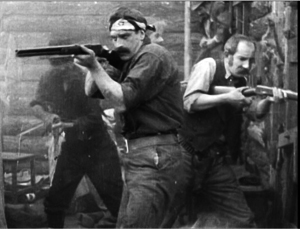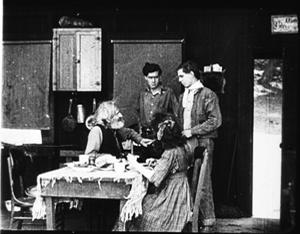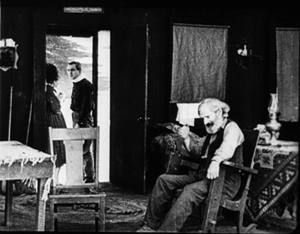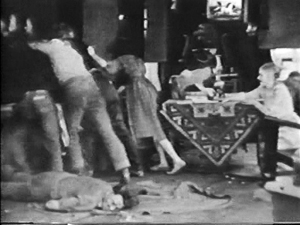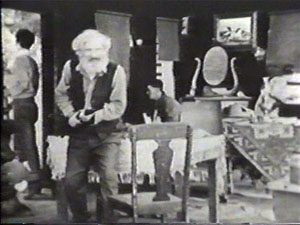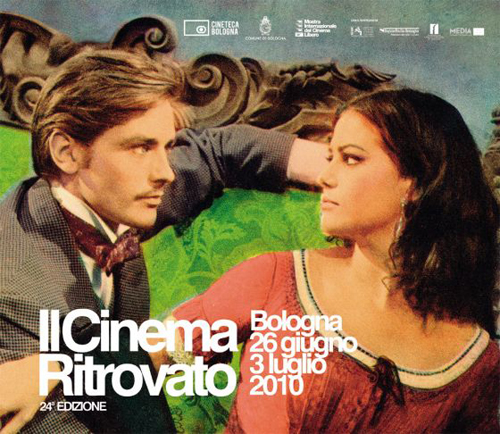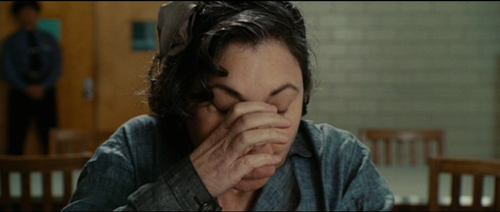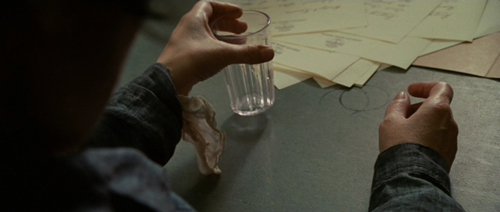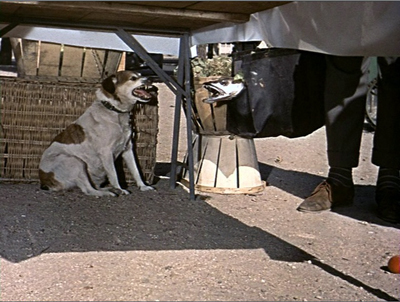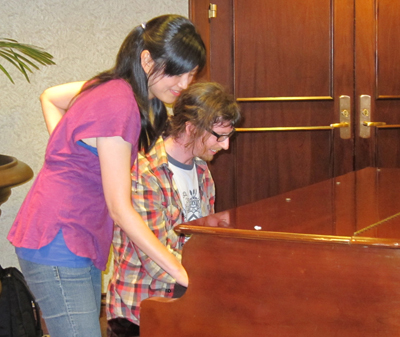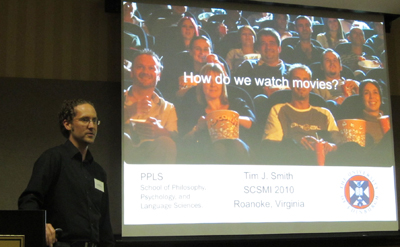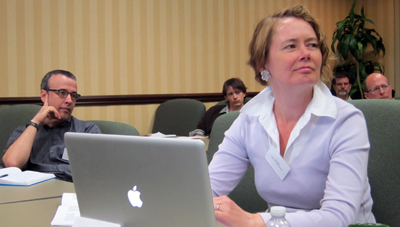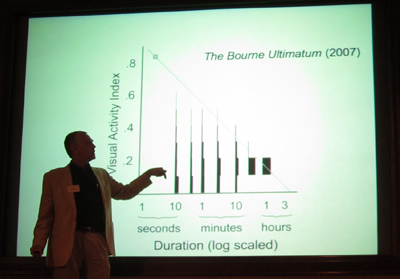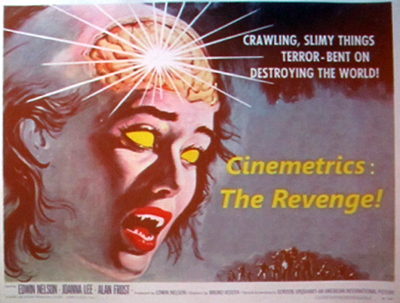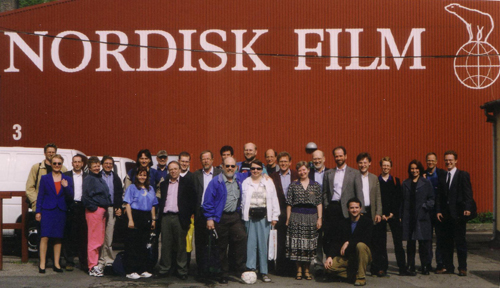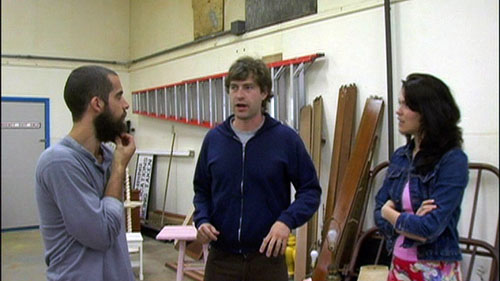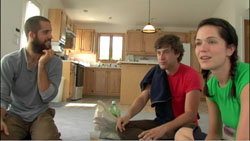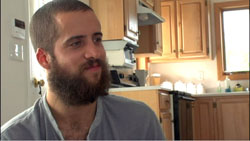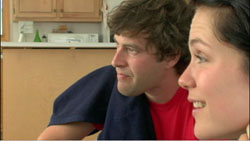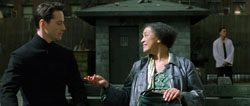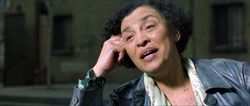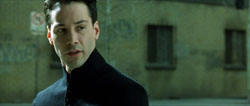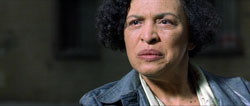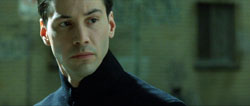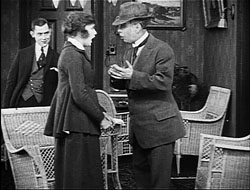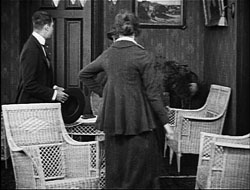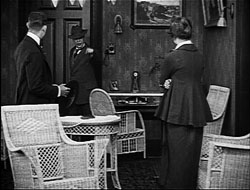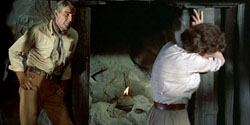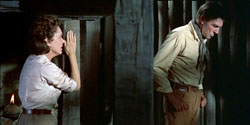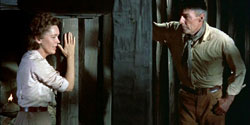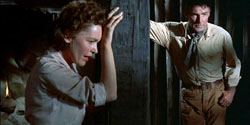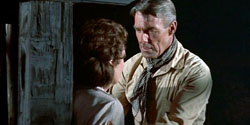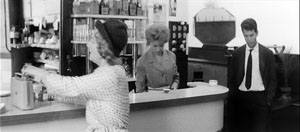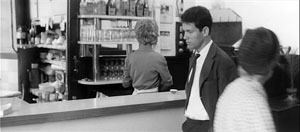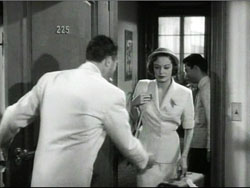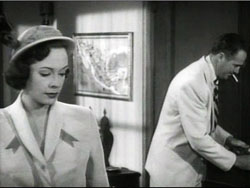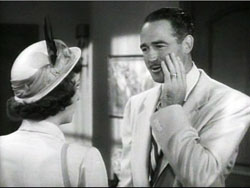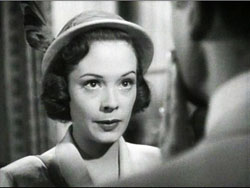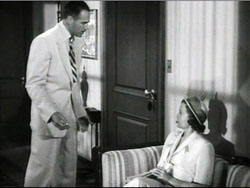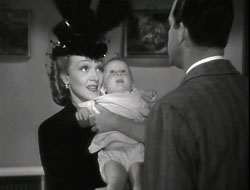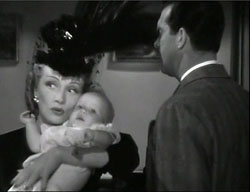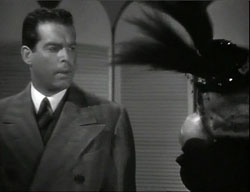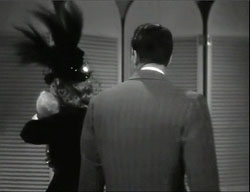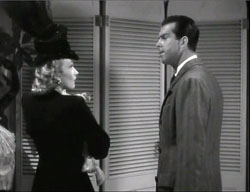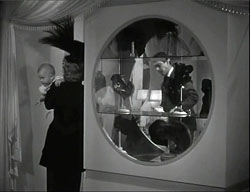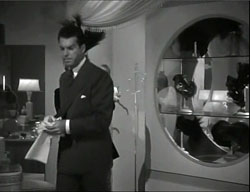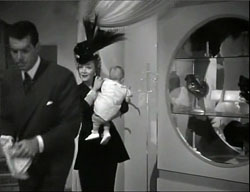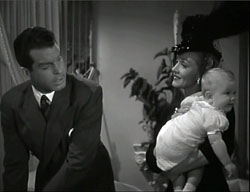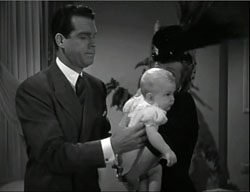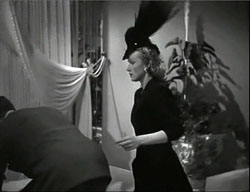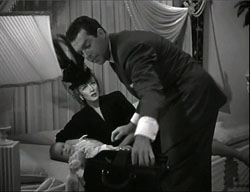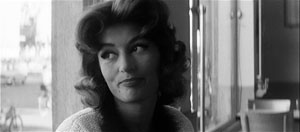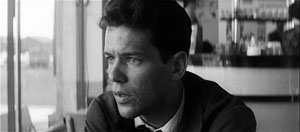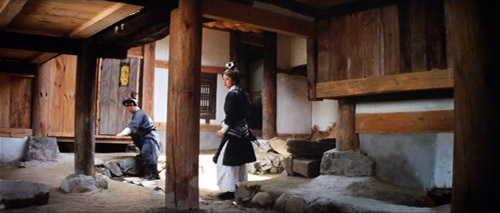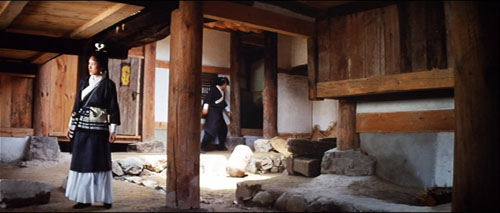Archive for the 'Film technique: Editing' Category
INCEPTION; or, Dream a Little Dream within a Dream with Me
Kristin here:
Inception reminds me of the common claim that Hollywood films are no longer character-centered. Special effects and slam-bang action supposedly have replaced character traits as the basis for storytelling. Now, here is a contemporary film released as a summer tentpole film and definitely successful in box-office terms. It crossed the $200 million domestic gross figure on Tuesday, August 3. Yet the nearly universal complaint, for those who don’t like the film, or some aspects of the film, is that we don’t get to know the characters.
If modern tentpoles have generally neglected characterization, that must be a convention by now. Why would people expect to find rounded characters? Is this complicated/complex (take your choice) intellectual film aimed at adults ironically going to prove that the critics of modern Hollywood blockbusters have been right all along?
I agree that the characters in Inception, apart from Cobb, the protagonist, are barely assigned traits. Ariadne, for example, does not return to join Cobb’s team as its architect because she has some personal goal or trait that inclines her to want to do so. It’s just that everyone who experiences the possibilities of shared dreams gets hooked.
But if there’s little characterization, is Nolan substituting something interesting in its place—apart from the usual computer-effects and spectacle? The first time I saw the film, I suspected he is, but for a long time I couldn’t figure out what. As a result, I did not really enjoy it until the point where the van breaks through the railing on the bridge and starts to fall. That’s pretty far into the film, 104 minutes in a roughly 140-minute film, not counting the credits. The van’s beginning to fall also marks the end of what we’ve called the Development portion of the film and the beginning of the Climax. (See here and here and here.)
At that turning point, it dawned on me that Nolan has elevated exposition of new premises to the main form of communication among characters. Discussion of their personal relationships, hopes, and doubts largely drops out. As the Russian Formalists would say, exposition, usually given early on and at wide intervals later in a plot, becomes the dominant here. That’s an unusual enough tactic to warrant a closer look.
We grasp most of the characters by the types of premises they provide. Yusuf is the man who understands how to manipulate the sedatives that will allows the team to progress deep enough into Fischer’s subconscious to plant the idea. Oh, yes, and he has a cat. Robert Fischer is the man who thinks his father despised him, so he is susceptible to the team’s machinations to plant the idea in his subconscious. (Saito says that Fischer has a “complicated” relationship with his father, but it’s actually just the opposite: a single trait, which is all that’s needed to establish his part in the action.) He also seems to be very concerned with security, since his subconscious conveniently peoples the dream levels with bodyguards who provide obstacles, fatally wound Saito, and force the van off the bridge, among other functions.
The characters’ goals, apart from Cobb’s, arise from the premises of the dream-sharing technology. Of course, they want to get paid, but that’s assumed. Their actions all arise from the need to keep doing what they must to sustain the dreams and later from the need to improvise solutions to unforeseen problems that seem to violate the rules they have previously known. Why they need the money, whom they go home to when off-duty, how they got into this business, and all the other conventions of Hollywood characterization, are simply ignored. Even Saito’s claim that Maurice Fischer’s corporation is dangerous to the world because it controls so much of its energy sources is simply assumed to be true. Our possible suspicions that Saito himself might really be the more dangerous tycoon, out to eliminate a powerful rival, might add a little complexity. The film, however, never hints at such a possibility.
Ariadne is somewhat different in her function. As in so many Hollywood films, there are two lines of action. First, there is the attempt to perform inception in Fischer’s subconscious. Second, there are Cobb’s related goals of getting back to his children but also of holding onto his dead wife through his visits to his projection of her in dreams. No one besides Ariadne fully understands Cobb’s obsession with Mal and hence she alone sees the danger it poses to the team. Ariadne lives up to her ancient namesake, guiding us through the maze of the Cobb’s obsession by acting as an expository figure in that storyline.
That is presumably why she doesn’t simply tell Arthur, who is much more experienced than she is in sharing dreams, about Cobb’s dangerous obsession. Instead, she decides to go into the dream levels as part of the team to keep on eye on Cobb—thus allowing her to continue as a privileged witness and transmitter of vital information about that storyline.
Each new premise creates a link in the chain of actions, and for the most part the actions are governed by the rules, or apparent rules of the dream-sharing machine, the sedatives, the levels, the characters’ respective skills, and all the other factors.
The narration constructs its causal chain by being nominally omniscient. For short stretches of the film we may be “with” Ariadne and Cobb or Mal and Cobb and witness them having personal conversations, most dramatically when Cobb fails to talk Mal out of leaping to her death. These moments provide the main alternative to the exposition-ridden dialogue, and they are a very small portion of the overall speech in the film. Yet the narration arches over all, stitching together the series of causes by moving us among the levels, catching at exactly the right moment the critical action (Arthur is putting a stack of dreaming people into an elevator) or dialogue (Cobb is asking Ariadne where she designed a route bypassing the labyrinth in the hospital).
Once I realized that this film’s plot concerns fiendishly complicated action that requires almost constant exposition from the characters, I enjoyed the rest of it. I saw it a second time and enjoyed it even more. I certainly don’t understand the entire plot, and I suspect that’s partly because, despite the nearly constant revelation of premises, there were a few left out. For one thing, just how does Eames, the “forger,” manage to change into other people? (No mention of polyjuice potion or anything else.) I can understand how he might do it in his own dreams, but the one dream where he doesn’t change is his own. Even the guides to Inception that have already been posted on the internet don’t answer every question. (Here and here are two examples of many.) Perhaps when the DVD comes out, the answers will be forthcoming—more of them, but probably not all.
In the meantime, I don’t see why we should get annoyed because Inception doesn’t contain rich, fully rounded characters. It’s clearly a puzzle film that takes the usual complicated premises of a heist movie and pushes them to extremes. Accepting the flow of nearly continuous exposition may remove some of the frustrations viewers face. After all, there’s no rule against it.
DB here:
When an actor comes to me and wants to discuss his character, I say, “It’s in the script.” If he says, “But what’s my motivation?”, I say, “Your salary”.
Alfred Hitchcock
Forget dream stuff for a while. Yes, Nolan says he was interested in dreams, especially lucid dreaming. Yes, he claims that the precision of detail in the film was an effort to suggest how “real” dreams feel when you’re having one. And yes, critics have defended the films’ dream worlds as realistic, or attacked them as phony substitutes. All interesting points and worth exploring, but not my focus at the moment.
And forget videogames. I leave that stuff to the experts, such as several members of our Wisconsin Filmies listserv. They have kindly pointed out many analogies and disanalogies. (See the coda for specifics.) And of course there’s no shortage of commentary about the film’s ties to gaming, or dreaming, on the Net.
My focus instead is motivation. Not the sort that Hitchcock and Bergman talked about, but rather the idea that any artwork needs to justify certain elements or strategies it presents.
Motivation beyond Bergman
You want your movie to have musical numbers. How to justify them in your story? Many early musicals simply make the characters show-business types, so we see them rehearsing and performing numbers for the audience. Other musicals cast that “realistic” motivation aside and let the characters sing and dance wholly for one another. But then those films were appealing to a sort of motivation familiar from opera, where characters simply burst into song or dance without realistic motivation. We accept this type of artifice too because that’s just what this genre of film permits—the way that horror films include monsters that are unlikely to exist in the real world.
The notion of motivation turns a lot of our usual thinking about cinema inside out. Usually we think that something is present in order to support what the film “says.” But actually a lot of what we find in films is motivated, either by genre or by appeal to realism, in order to give us a particular narrative experience.
For a couple of decades, some American cinema (both Hollywood and indie) has been launching some ambitious narrative experimentation. We’ve seen “puzzle films” (Primer), forking-path or alternative-future films (Sliding Doors), network narratives (Babel, Crash), and other sorts. This trend isn’t utterly new—there are earlier cases, especially in the 1940s—but it seems to have been accelerating in recent years, particularly after Pulp Fiction (1994). Christopher Nolan has participated in the trend as well, with Following and Memento.
The film industry encourages some degree of innovation. Novelty can attract attention, and perhaps audiences too. Yet, as I argued in The Way Hollywood Tells It, such innovations are counterbalanced by traditional storytelling maneuvers. These make sure that audiences aren’t entirely lost. For example, Memento’s backward structure requires very explicit signposting of the transitions, highlighting objects or gestures we’ve seen in the previous time-slice to link them to the next one we see. At the same time, these experiments can pay off financially: a complex narrative that balances enigma and understanding can lure audiences to revisit the multiplex or buy the DVD for further scrutiny. Remember, we are all nerds now.
Memento illustrates a couple of ways in which Hollywood efforts at innovation are controlled by tradition. First, you can motivate a film’s formal play through genre conventions. A science-fiction film, for instance, can invoke time travel or alternate universes. Doc’s time machine in the Back to the Future series motivates a fairly unusual play with cause and effect, particularly in the second installment. Likewise, mystery and detective stories pioneered the “lying flashback,” when people give false testimony about a crime (as in Crossfire). The possibility that a film noir will encourage complicated narration (an optically subjective first-person narrator in The Lady in the Lake, a dying narrator in Double Indemnity, a dead one in Sunset Blvd.) helps us recognize that Memento is an experiment in that tradition.
Second, you can motivate formal experiment through the movie’s appeal to some widely-believed law of life, a common-sense realism. Uncanny coincidences in movies like Serendipity and Sliding Doors are justified by the notion that fate or spiritual harmony can bring soulmates together. Six Degrees of Separation’s plot exploits the idea of social networks. Likewise, the backward progression of Memento’s plot is partly justified by the clinical condition of short-term memory deficits. I grant you, why this ailment supports a reverse-chronology tale is a bit puzzling—but that may only suggest that we’re ready to overlook flimsy justification if the novelty is piquant enough. A little motivation can go a long way.
So we ought to recognize that Inception is relying heavily on motivation from these two sources, genre and commonsense realism. Science fiction grants the possibility of entering people’s dreams through a futuristic technology. Likewise, we have all experienced dreams, so the film can appeal to folk wisdom about them. I suggest, though, that the purpose of the film not to explore the dream life but rather to use the idea of exploring the dream life to justify creating a complex narrative experience for the viewer. That is the purpose of the film; the dreams operate as alibis.
Interestingly, traditions outside Hollywood don’t require these sorts of motivation for narrative experiments. Last Year at Marienbad is perhaps the supreme example of a purely artificial construct, which can’t be justified by genre or subject/theme. I’d argue that Kieslowski’s Blind Chance, Buñuel’s Obscure Object of Desire, van Dormael’s Toto le héros, and other films of a highly artificial cast either ignore or cancel both realistic and generic motivation. They present themselves as experiments in storytelling, pure and simple. Another art-cinema motivational ploy invokes psychological realism, as in Fellini’s 8 ½. This is less daring than the blunt-artifice option, and so has been more easily adapted to mainstream storytelling.
One more point about the New (or now Not-So-New) Narrative Artifice. Strategies that seemed striking in the pioneering films are quickly mastered by others. Innovations are copied, and the learning curve is steep. By now anybody can create a fairly coherent network narrative or forking-path tale. Artistically ambitious filmmakers want to press further. So how can you create fresh experiments in storytelling today?
Architecture beyond Ariadne
If you decide to organize a film in sharply distinct plotlines, you have two problems. First, how do you combine them? What will be the overall architecture? Second, how do you fill in the chain of actions?
Consider combination first. You can create parallel plotlines, as in Intolerance’s assembly of four different historical periods or in Vera Chytilová’s Something Different, in which two women living at the same moment lead very different lives. You can create branching or forking-path plotlines, as in Run Lola Run. You can link stories through a simple overlap, as in Wong Kar-wai’s Chungking Express, or by letting them pass through the same place; the inn in Wong’s Ashes of Time functions as a sort of node that gathers together the destinies of different characters.
One sort of plot construction that hasn’t been explored deeply in recent years is actually one of the oldest. The embedded story, or the tale-within-the-tale, dates back at least to The Odyssey. In the standard case, we have one level of story reality, and in that a character tells a story that takes place earlier and elsewhere. Typically the embedded story is pretty extensive, with its own structure of exposition, development, crisis, and climax. You can of course multiply the stories, as in The Arabian Nights, The Decameron, and The Canterbury Tales.
Sometimes the framing story is merely a backdrop, though usually that has its own dramatic impetus: Scheherazade tells a story each night to postpone her death. Often, though, the framing situation carries the main interest. In Don Quixote, readers are tempted to skip the tales told by people whom the knight and Sancho encounter, in order to get back to the real story, the relationship of the central pair.
The “discovered manuscript” convention of nineteenth-century fiction was an equivalent of this pattern, a sort of novel-within-a-novel. Some experimental fiction has exploited the embedded story; I think of Calvino’s If on a Winter’s Night a Traveler. The principle of embedding has been found in cinema too, of course. Citizen Kane is the classic example, since it embeds recounted stories (most of the flashbacks), a written text (Thatcher’s memoirs), and even a film-within-a-film (News on the March). Many of the embedded stories we find in films are presented as flashbacks, and those are usually motivated by a character recalling or telling another character about past events. (See our blog entry “Grandmaster Flashback” for some more discussion.)
The task of the author is to motivate the story’s presence through relevance to the framing situation. Why insert the tale in the first place? Most commonly, it involves some of the same characters we find in the surrounding story world, as in a flashback. In that case, the embedded tale supplies new information about plot or character. It may also provide a parable or counterpoint to what’s happening in the surrounding situation. In The Sin of Madelon Claudet (1931), a woman is about to leave her husband, but she changes her mind when a family friend tells her, for the bulk of the movie, about the sacrifices made by the husband’s mother.
Some researchers might argue that the purest instance of this format is one in which the characters of the overarching frame story don’t participate in the embedded tale. Classic instances like the Mahabhrata are often studied as compilations. A partial instance in cinema is the country-house frame story of Dead of Night, in which some characters recount stories that didn’t involve them. Here the frame story arouses considerable interest in its own right.
Once you allow the possibility of an embedded story, some storyteller will ask: Why not embed a story into the embedded story? And so on. Calvino’s novel does this, suggesting the possibility of that infinitely extended series we see when somebody stands between two mirrors and the image is multiplied forever. (Inception gives us such an image when Ariadne summons up mirrors on a Parisian street.) Hollywood filmmakers experimented with multiple embedding in some flashback films of the 1940s. In The Locket and Passage to Marseille, there are flashbacks within flashbacks. More daring, and closer to Calvino, is Pasolini’s Arabian Nights, in which one character recounts a tale in which he encounters another character, who recounts his tale, and so on.
Here, I think, is the accomplishment of Nolan’s film. The general absence of complicated embeddings today (at least since The Matrix) presents an opportunity for an ambitious moviemaker. Inception constitutes an extended experiment in what you can do with a nested plot structure, motivated by the dream-invasion premise.
The Dream team
Nolan adds a new wrinkle. Instead of recounting or recalling stories, the characters enter worlds “hosted” by one of their number and furnished by another. The movie introduces this strategy to us obliquely. After the prologue in which Cobb confronts a very aged Saito in Limbo (which I think you can take as either a flashforward or a symptom of their collaborative dreaming at the moment), we are plunged into layers of embedding. In the real world, Cobb, Arthur, and the architect are dreaming with Saito on a train; we later learn that this is an audition to test Cobb’s extraction skills. They dream that they are in an apartment where Saito meets his mistress. But in that apartment they are sleeping, and dreaming that they are in a luxurious mansion where Cobb is trying to discover Saito’s secrets. That effort is disrupted by Mal, Cobb’s ex-wife, and the dream world collapses.
What’s tricky is that Nolan doesn’t establish these layers of embedding in customary order. The flashback tradition leads us to expect to move from outside to inside, like peeling an onion: from the train to the apartment to the mansion. Instead, we are first shown the mansion, and we get glimpses of the apartment. That tactic hints that the apartment is the primary level of reality in the fiction. But in the apartment Saito notices discrepancies in the carpet, making him realize he’s dreaming. Only then does Nolan shift to the external frame, the four men on the train, minded by a young Japanese passenger.
This has been our first training exercise, and it turns out to be based on surprise: We weren’t aware of how many embedded plotlines were in play. In the film’s terms, the dream session on the train went down two levels. Cobb says he can go down three, and that forms one goal for the team.
Later exercises are simpler, involving only shared dreams rather than embedded ones. That’s because these dreams operate as tutorials, as when Cobb shows Ariadne how dreamworlds are constructed and populated (though the framing situation is deleted at the outset–another, if milder, surprise). The dreams also function as psychological probes, as when Ariadne learns that Cobb’s unresolved problems with his wife are expressed in her eruptions into whatever dreamworld is conjured up. These études have to be relatively transparent if we’re to understand all the premises of this game. Similarly, our introduction to Limbo is given not through dream-penetration but through a good old flashback, when in the first-level dream world Cobb confesses to Ariadne that he and Mal built their own dreamscape there. Limbo changes the rules of the game to such an extent that we shouldn’t have to worry about who’s dreaming what for whom; a straightforward piece of visual exposition does the trick.
The most intricate embedding takes place in the final seventy-five minutes, most of the second half of the film. Instead of a train, a plane. Instead of four dreamers, six: the target young Fischer, plus all the members of the team, including Ariadne, who will monitor Cobb’s subconscious. Each team member hosts one story world, the other members enter it, and Fischer gets to populate it. Yusuf the chemist hosts the rainy car chase that leads to the van’s descent to the river. Arthur the point man hosts the hotel scene in which Cobb accosts Fischer. Eames the Forger (or rather the imposter) hosts the snow fortress siege, in which Fischer is induced to confront his dying father (thinking he is entering the dream of the family confidant Browning). Finally, to pursue Mal, Cobb and Ariadne plunge into the beachfront/ metropolis zone of Limbo constructed by the couple during their dream days. It’s then revealed that Cobb brought about his wife’s idée fixe by planting the idea that dreams could become reality; this showed him, with tragic consequences, that inception could work.
So we have five levels: the plane trip embeds the rainswept chase, which embeds the hotel, which embeds the snow fortress, which embeds the Limbo confrontation. The nested structure is recapitulated in the burst of shots showing Ariadne snapping awake in each level up to the submerged van (dream level 1).
Indeed, I think that one prime purpose of Nolan’s fancy structure is to foster such little coups. The Ariadne passage is cinematically simple—just a string of quick, graphically matched close-ups—but in context arresting. Of course that context displays a clockwork intricacy. What Nolan has done is created four distinct subplots, each with its own goal, obstacles, and deadline. Moreover, all the deadlines have to synchronize; this is the device of the kick, which ejects a team member from a dream layer. With so many levels, we need a cascade of kicks.
The last forty-five minutes of the film become an extended exercise in crosscutting. As each plotline is added to the mix, Nolan can flash among them, building eventually to four alternating strands—with additional crosscutting within each strand (in the hotel, Cobb at the bar/ Saito and Eames in the elevator/Arthur and Ariadne in the lobby). Each level has its own clock, with duration stretched the farther down you go. One thing that has long struck me about classical crosscutting is that in one line of action time is accelerated, while in another it slows down. The villains are inches away from breaking into the cabin/ the hero is miles away/ the villains are almost inside/ the hero is just arriving. I wonder if Nolan noticed this aspect of the crosscutting convention and built it into his plot, supplying motivation (that word again) by stipulating that different dream levels have different rates of change.
Another clever touch is what Nolan doesn’t include in the orgy of crosscutting: the framing situation in the first-class jet cabin. Once we leave that, we don’t see it again for about seventy minutes. I think we tend to forget about it, so that Cobb’s startled expression upon finally awakening mimics our own realization that all the intense physical action has been enframed by this quiet, stable situation.
I think that structurally, if not stylistically, the climax is a virtuoso piece of cinema. It recalls Griffith’s Intolerance, which also intercuts the climaxes of four plotlines, and supplies crosscut lines of action within each line as well. Here, one might say, is one way to innovate in the New Narrative Artifice: Create something like the Intolerance of the twenty-first century.
Possible, and not that unstable
The film is shameless in its regard for cinema, and its plundering of cinematic history. What’s fun is that a lot of people I talk to come up with very different movies that they see in the film, and most of them are spot-on. There are all kinds of references in there.
Also like Griffith, Nolan has hit upon some ways to make his innovation user-friendly. For one thing, as most viewers have noticed, he situates his levels in very different locales: rainy, traffic-filled city versus eerily vacant metropolis; cushy hotel versus more Spartan one; beach versus mountains. This allows us to keep oriented during even the most rapidly cut portions. More subtly, Nolan has, deliberately or not, respected the limits of recursive thinking, or metacognition.
As shrewd members of a very social species, we are all good at mindreading, figuring out what other people are thinking. I know that Chelsea admires Hillary. We’re good at moving to the next level too: I know that Chelsea believes that Hillary wants to monitor Bill. And I know that Chelsea believes that Hillary suspects that Bill is smitten with Monica. If you drew this situation as a cartoon, you’d have one thought bubble inside another inside another, and so on—like the Russian-doll structure of the climax of Inception.
It turns out that our minds can’t build these nested structures indefinitely. We hit a limit.
Peter believes that Jane thinks that Sally wants Peter to suppose that Jane intends Sally to believe that her ball is under the cushion.
Robin Dunbar, whose example this is, suggests that most adults can’t handle so much recursion. His experiments indicate that the normal limit is at most five levels—just what we have in Inception (four dream layers plus the reality frame). Add more, and most of us would get muddled.
The filmmaker’s second big problem with modular plotting, I mentioned near the start, is how to fill in the plotlines. Let me suggest a general principle, at least for storytelling aimed at a broad audience: The more complex your macrostructure is, the simpler your microstructure should be. In Memento, the high degree of redundancy between memory episodes and the unusually heightened transitions help us track the backward layout of scenes. Similarly, all four episodes of Intolerance culminate in a race to the rescue—a device that was by 1916 immediately legible for audiences.
Genre plays a role in simplifying the modules too. Our efforts to make sense of Memento are helped by film noir conventions like the trail of clues, the deceptive allies, and the maneuvers of a femme fatale. Likewise, Griffith used the conventions of current genres to fill in the plotlines of Intolerance. The Christ story can be seen as a recasting of the many pious Passion plays of the first years of cinema. The Babylonian story and the Huguenots’ story rely on the established conventions of the costume pictures, including the French and Italian features that were popular at the time. (Capellani, discussed in an earlier entry, was one master of this genre.) And of course Intolerance’s modern story is pure melodrama, showing a young family pulled apart by the forces of urban poverty and bluenose reform. Griffith wove together not only four epochs but several genres.
So does Nolan in Inception. He recruits the conventions of science fiction, heist movies, Bond intrigues, and team-mission plots like The Guns of Navarone to make the scene-by-scene progression of the plot comprehensible. The iterated chases and fights keeps us grounded too, though you might wonder why Fischer’s subconscious projections all seem to have leaped out of a Bruckheimer picture. And of course you’ve seen many of the other images before, from the Paris café to the luxury hotel bar. Shamelessly clichéd, the image of kids playing in the sunlight immediately evokes fatherhood and family in any film.
I’ve already argued that the comparatively transparent training and exploration sessions in the middle of the film help us keep our bearings. Another handhold is the convention of the new male melodrama, the husband or boyfriend trying to come to terms with the death of his woman. The simple action movie, from Death Wish to Bad Boys, uses vengeance to ease the man’s torment. The more “serious” plot makes the man responsible in some degree for the woman’s fate. The emotional temperature rises as the male protagonist tries to fight his feelings of guilt, turning it outward to a perpetrator (as in The Prestige) or inward (as in Memento, and Shutter Island). The under-plot of Inception, driven by Ariadne’s curiosity, gradually reveals to us that Cobb gave Mal the fatal idea of dwelling in dreams.
Moreover, the rise of fantasy, science-fiction, and comic-book movies has brought a new interest in creating “worlds” with their own laws. Once you have Superman, you need a secret identity and Kryptonite and well-placed phone booths, not to mention a host of constraints on what can and can’t happen. Comic books supply not only a world furnished with characters and settings but also rules about conduct, morality, even physics. George Lucas, in his youth more of a comic-book reader than a cinephile, took over this principle of construction for Star Wars. Of course this idea of richly furnished, rule-governed worlds has been elaborated more fully in videogames. My point is that contemporary viewers are ready to ride with this as another convention of contemporary virtual-world storytelling, and this habit simplifies our pickup of the rules governing Inception’s embedded stories.
In sum, as ambitious artists compete to engineer clockwork narratives and puzzle films, Nolan raises the stakes by reviving a very old tradition, that of the embedded story. He motivates it through dreams and modernizes it with a blend of science fiction, fantasy, action pictures, and male masochism. Above all, the dream motivation allows him to crosscut four embedded stories, all built on classic Hollywood plot arcs. In the process he creates a virtuoso stretch of cinematic storytelling.
I could find faults. As in The Dark Knight, Nolan’s action scenes are clunky and distressingly casual in their composition and cutting. He is much better at mind games than spatially precise physical activity. Some dialogue could be pruned too. (What are you doing here? He loved you–in his own way. Something is happening…as we speak.) And I haven’t even posed the interpretive issues. Find a sympathetic young woman to exorcise the demonic wife you can’t quite abandon. Find a new father figure (Japanese mogul) to replace the old one (Brit architect). Use the spinning top to exemplify both change and stability, childhood and maturity, and/or the unending flux of narrative. As Kristin hints, the whole thing might actually be complicated rather than complex; instead of a dense but coherent cluster of principles we might have a shiny contraption, bolting on new premises as it hurtles along.
Nonetheless, if current excitement about this movie is any measure, Nolan has pulled off the big balancing act. The film is redundant and familiar enough to let most of us follow the main trajectories on the first pass. Yet it’s enigmatic, elliptical, and equivocal enough to keep many of us talking about it. . . and watching it again. Recidivism, thy name is Inception.
Based on Uncle Scrooge? That’s rich!
Kristin back again:
There has been much suggestion on the internet, sometimes in jest, sometimes in earnest, sometimes half in jest and half in earnest, that Nolan got the idea for Inception from an Uncle Scrooge comic story with a shared-dream premise, “The Dream of a Lifetime!” Nearly all postings on this subject date this comic, created by Don Rosa, to 2002. Yes, “Dream” first appeared in 2002—in Danish. It came out in the U.S. in the May, 2004 issue of Uncle Scrooge (Gemstone #329). In 2006, it was reprinted in Rosa’s book, The Life and Times of Scrooge McDuck Companion.
A download of “The Dream of a Lifetime” is available online, but it is missing a page, so I’m not linking it here. The Companion volume is out of print but can still be purchased here. It contains Rosa’s “The Making of ‘The Dream of a Lifetime!’” “The Dream of a Lifetime” is included in the tenth and final volume of a series reprinting all of Rosa’s duck stories chronologically by their original appearance. The “Behind the Scenes” section at the back leads off with a revised version of “The Making of ‘The Dream of a Lifetime!'” Here Rosa mentions the theory that Inception was based on his comic tale. He saw the film only after reading about this on the internet and being skeptical of fans’ claims. His comment upon seeing the film is “And … whoa … I was no longer so dismissive of those internet theorists. There are so many elements in Inception that match aspects of my story very closely! Ah well–no matter.” (p. 175)
If Nolan got the idea from the Rosa tale, which seems unlikely, he certainly developed upon and changed it considerably. In fact, there are more significant differences than similarities.
First, the similarities:
1. In “The Dream of a Lifetime!” several people enter the dream by being hooked up to a machine. Here it’s a radio-controlled device invented by Gyro Gearloose, who intended for it “to help psychiatrists examine the dreams of their patients.” (Gearloose was created in 1952 by Carl Barks to provide whatever wacky invention his plots required.) The receivers are metal colanders wired as antennae and worn on the heads of the people sharing the dream.
2. Waking up from visiting the dream is triggered by falling (see below).
3. Characters in reality can attempt to insert objects or situations into the dream by making sounds or presenting objects for Scrooge to smell, though this usually goes comically wrong. This somewhat resembles the premise that the jolts of the van in the first dream level of Inception cause earthquake-like rumbles in the second level and so on.
4. The characters frequently explain to each other how the shared-dream technology works. Rosa makes this humorous in part by starting the story with Scrooge dreaming and the Beagle Boys arriving in his money bin with the Gearloose equipment, which they have already stolen. He then makes the exposition deliberately clunky and obvious. One of the stupider Beagles asks, “Sure … uh … tell me again how it works?” There are then several panels of explanation as the group arranges the equipment to enter the dream. As they are about ready, one remarks, “But I’ll explain later” how they will get Scrooge to tell them the combination to his vault.
5. All of the characters who enter Scrooge’s mind are aware that they are in a dream, as is Scrooge, who has had each of these dreams many times.
Now, the differences:
1. There is a single dreamer throughout, and Scrooge remains in his own bed.
2. There is only one level of dreaming, and Donald, who enters the dream to foil the Beagle Boys, returns at intervals to the bedroom to report progress and plan strategies.
3. Spatially, the dream extends only a short distance around Scrooge. If the characters move too far from him, it fades out, which Rosa represents by having portions of the panels go white. The Beagle Boys exit the dream, one by one, by falling into the white void (see below).
4. Scrooge’s dreams are essentially flashbacks, though they are altered by the other characters who enter the dreams. The plot passes through a series of seven recurring dreams, all based on real adventures Scrooge has had in the distant past. Each of the seven dreams derives from situations in Rosa’s The Life and Times of Scrooge McDuck series. (The one-volume edition of this series is out of print, but it still is available in a two-volume version, here and here.) These dreams take place out of chronological order, and Scrooge’s age changes with each new dream. (The stories are “The Vigilante of Pizen Bluff,” #6, Scrooge age 23; “The Dreamtime Duck of the Never Never,” #7, age 29; “The Master of the Mississippi,” #2, age 15; “The Empire Builder from Calisota,” #11, age 45; “The Buckaroo of the Badlands,” #3, age 15; “The Last of the Clan McDuck,” #1, age 10; and “Hearts of the Yukon,” #8C, age 31.)
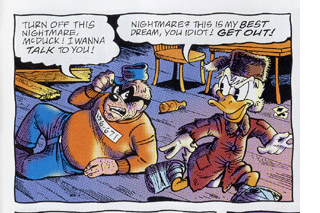 5. The rules are relatively simple. Crucially, Scrooge may be any age within the current dream, but he, being the main dreamer, recognizes Donald and the Beagle Boys.
5. The rules are relatively simple. Crucially, Scrooge may be any age within the current dream, but he, being the main dreamer, recognizes Donald and the Beagle Boys.
6. “Dream” is designed to be funny, as when the Beagle Boys keep complaining that they’re in a nightmare, while Scrooge thinks of them as pleasant dreams. This is normal life to such an adventurous character.
It should be clear that the complexity of Rosa’s story originates not from the shared-dream structure, which is fairly straightforward. Rosa is more interested in finding a way to rework some of the scenes from his earlier biographical Scrooge comics. The whole Life and Times project originated from Rosa’s working method of teasing out minutiae about Scrooge from the original Carl Barks stories and then concocting sequels or prequels to them. Life and Times is an attempt to use all the mentions of past events, relatives, locales, and dates to devise a biography of Scrooge. “Dream of a Lifetime!” carries that modus operandi one step further.
The other big difference between “Dream” and Inception is that a reader who was not familiar with the seven earlier stories would miss much of what goes on in “Dream.” It was written for McDuck aficionados as a sort of game of recognition. For those who do recognize the seven situations referenced, “Dream” is quite easy to follow. For those who don’t, it must seem complicated and mysterious, most crucially since they won’t recognize Glittering Goldie, Scrooge’s lost love, in the opening “private” part of the dream.
In contrast, Inception is self-contained and tries for a very different sort of game of comprehension with the viewer, one which would not be aided by knowledge from other Nolan films.
“Dream” is also recognizable to fans as another of the “trick” stories that Rosa has written occasionally. These are not linked to Barks’s stories but develop some simple premise that allows Rosa to play with time and space in virtuoso fashion. These include “Cash Flow,” where the Beagle Boys buy an anti-friction ray-gun (Uncle Scrooge, Gladstone #224); “The Beagle Boys vs. the Money Bin,” (Uncle Scrooge, Gemstone #325), where the Beagle Boys find a map of the money bin; and my favorite, “A Matter of Some Gravity” (Walt Disney’s Comics, Gladstone, #610), where Magica de Spell buys a wand that turns gravity sideways for Scrooge and Donald.
In short, if Nolan ever saw “Dream of a Lifetime!” it could only have given him a few ideas out of the many that went into Inception.
DB coda:
For more discussion of the art of Christopher Nolan, see his category on the right-hand side of the page. We have an analysis of sound in The Prestige in the ninth edition of Film Art: An Introduction, and there we discuss the film’s narrative strategies as well.
Despite not caring for the movie, Jim Emerson has been assembling a wide-ranging and long-running dossier on Inception, with many comments. Scroll down the several entries here. Likewise visit David Cairns, who makes the necessary Anthony Mann comparison. The Wikipedia entry on the film is information-packed, and it includes several helpful links.
Our UW informants suggest that videogames having affinities with Inception include Assassin’s Creed II, Meigakure, and Shadow of Destiny. Thanks to Jason Mittell, Tim Palmer, Evan Davis, Leo Rubinkowski, Ethan de Seife, Edward Branigan, and Andrea Comisky for suggestions. See also Kirk Hamilton’s “Inception’s Usability Problem.”
On fourth-and fifth-level mindreading, see Robin Dunbar, The Human Story: A New History of Mankind’s Evolution (London: Faber, 2004), pp. 45-52. Dunbar’s study found evidence suggesting that women are better at tracking recursive mental states than men are.
Jan Simons offers an analytical survey of writing about New Artifice in an article here. For interpretations of particular films within the trend, see Allan Cameron, Modular Narratives in Contemporary Cinema (Palgrave Macmillan, 2008) and Warren Buckland, ed., Puzzle Films: Complex Storytelling in Contemporary Cinema (Wiley-Blackwell, 2009). I try to lay out some narrative principles governing such films, including Memento, in The Way Hollywood Tells It and in the essays “Film Futures” and “Mutual Friends and Chronologies of Chance” in Poetics of Cinema.
PS (17 December 2010): We have a rethink of Inception in this later entry.
[November 29, 2018: I have updated the section on Don Rosa’s “The Dream of a Lifetime!” by removing or updating dead links, correcting one error, and adding a few remarks on Rosa’s updated making-of essay on the comic. (KT)]
John Ford, silent man
John Ford on the set of Air Mail (1932).
DB here:
This is the busiest installment of Cinema Ritrovato I can recall. We scarcely have time to sleep, let alone blog. The coordinators Peter von Bagh, Gian Luca Farinelli, and Guy Borlée have outdone themselves in offering something for everybody, from early films to postwar French and Italian rarities up through a tribute to Stanley Donen and special screenings of The Leopard and Metropolis. Our attention has been riveted by the 1910 programs and an extensive collection of films directed by Alberto Capellani, a little-known master of silent film.
One headliner is the early Ford series: all his surviving silents, plus a selection of rarely-seen talkies. The first one screened, The Black Watch (1929), concentrates on intrigue in the Khyber Pass during World War I. Captain King is assigned to India while the rest of his Scots regiment is sent to Europe. In India, King masterminds the defeat of the forces of Yasmani, a woman who has been taken as sort of a goddess by her followers. The central section, involving Yasmani’s passion for King and his betrayal of her, seems to me sketchy and rushed; Ford’s real interest, not surprisingly, is in the rites of comradeship among the Black Watch. Twenty-two of the film’s 91 minutes are taken up with the opening dinner celebrating the regiment, conducted while King gets his assignment. Since his mission is secret, he abandons his comrades and suffers their opprobrium. A bookended sequence at the close shows him returning to the Watch as, in the trenches of war, they hold another dinner, complete with ruffles and flourishes.
Some of the central portion was directed by Lumsden Hare, but it too has some striking moments, perhaps most memorably the display of Yasmani’s powers when she conjures up an eerie vision of the European battlefield in a glowing crystal ball. The war sequences have the dank Expressionist look that Murnau brought to Fox and that Ford exploited in Four Sons (1928). There are as well touching train-station farewells between brothers and between father and daughter, all of which seem very Fordian. Overall, Ford finds ways to avoid the multiple-camera shooting common to early talkies, often using offscreen dialogue during reaction shots.
Also fairly free of multicamera work was The Brat (1931). Like many talkies derived from a creaky Broadway play, it entices us with a “cinematic” curtain-opener. Cops (including the young Ward Bond) hustle perps into night court, all captured in a flurry of high and low angles, bursts of deep space, and swift tracking shots. Afterwards things slow down, enlivened by some social satire (the pretentious novelist writes with a quill pen), a few sight gags (an artist’s muscled model who discovers he’s been rendered in a faux-Cubist image) and an all-in grappling fight between a society dame and a girl from the other side of the tracks. According to Ford, the fight got its impact from the fact that the actresses couldn’t stand each other.
The first silent Fords were introduced by Joe McBride. “When the real West ended,” Joe remarked, “the cinematic West began.” Born soon after the closing of the frontier, Ford was fascinated by cowboys and Native Americans. Early filmmakers were to a surprising extent celebrating the stoic Indians uprooted and forced to give up their way of life, and this resonated with Ford. The elegiac quality we find in The Man Who Shot Liberty Valance (1962) and other late films, Joe suggested, was already there in the genre. Ford’s own first Westerns, thanks partly to the presence of Harry Carey, carry an air of resignation to history. Even the fragmentary sequences surviving from The Secret Man (1917), in which Harry must sacrifice his freedom to save a little girl, have a severe melancholy.
Hell Bent (1920) has long been famed for its flashy, unrepeatable shot: A carriage pulled by horses tumbles into a ravine; the camera tilts down to follow the crash; and then the horses, freed at the top, come hurtling back into the frame to pass the wreckage. Otherwise the film is consistently agreeable, suffused with Fordian camaraderie among drunks and respect between hero and villain. This last element is starkly dramatized when Harry and his adversary, having wounded each other in a gun duel, must crawl through the desert together.
On my first viewing, I didn’t see in Hell Bent the inventiveness and grace notes I admire so much in Ford’s first feature, Straight Shooting (1917). As we’ve mentioned before, this film shows a mastery of the classical Hollywood style that emerged in the late 1910s. It bears comparison with William S. Hart films of the period, high points of filmmaking craft. Late in the plot Ford give us a shootout with ever-tighter framings that could have come out of Leone.
Whether Ford invented this particular piece of cinematic rhetoric we can’t say; too many silent films are lost. But coming from a 23-year-old filmmaker in his first feature, this remains a remarkably assured use of the continuity editing system for 1917.
Ford’s debt to Griffith has often been noted, and in this movie it turns up in unexpected ways. At one point Joan tenderly puts away the plate her dead brother had used, as if to preserve it. Later, Ford recalls the gesture when the cabin is under siege and bullets blow apart other plates on the sideboard. But Ford has already quietly suggested an association between brother Ted and Cheyenne Harry; as Joan kisses the plate before putting it away, Ford cuts to Harry outside, and then back to Joan slipping the plate into a drawer. Using the then-current technique of a “ruminative cut”, the editing suggests that Joan may also be thinking of Harry, and he of her. The idea of Harry replacing Ted is made explicit at the end when Sims plaintively asks Harry, “You be my son.”
The Griffith influence is particularly acute in Straight Shooting’s climax, when the farmers are under siege in the Sims cabin. Horsemen gallop around the cabin as hired gunmen pepper it with bullets. Meanwhile, Cheyenne Harry has persuaded Black-Eyed Pete’s gang of outlaws to rescue the settlers, and Ford gives us a rousing passage of rapid crosscutting. It’s a canonical last-minute rescue, straight out of the climax of The Birth of a Nation (191t5).
Or more particularly, I think, out of The Battle at Elderbush Gulch (1914). Griffith commonly staged interior scenes with doors at the left and right of the frame, letting actors play laterally. The strategy can be considered somewhat theatrical, in that we never see the “fourth wall” that would in reality enclose the characters.
But this leads to problems when you want to show your characters surrounded. In Elderbush Gulch, the settlers are besieged by encircling Indians. At one point, Griffith cuts from the exterior of the cabin to the interior, and to convey the sense of enclosure he has one of the settlers firing “through” the fourth wall, as if over the heads of the audience!
This is an awkward compromise, but at least give Griffith credit for grasping that his dollhouse playing area doesn’t fully render a realistic space. In Straight Shooting Ford provides a more three-dimensional rendering of interiors. Even though most scene in the Sims cabin lacks Griffith’s side walls, the set yields layers of depth, and the famous door in the back of the set opens on to the porch and the farm outside.
During the gunmen’s siege, we get a strong sense of enclosing space by virtue of the cuts of men firing from different angles. In addition, the cabin interior displays a little more angular depth.
But even Ford can’t escape compromises. We never see the space “behind us” in the Sims’ cabin, and as the farmers take up positions at windows, Ford shows us old Sims readying to fire by turning toward the camera and, like Griffith’s settler, aiming through the fourth wall.
The two shots of Sims in this posture go by fast, and they’re less noticeable because the siege hasn’t quite begun. Still, the anomaly indicates that in this setting Hollywood technique still doesn’t give the sense of a wraparound space that we get in the exterior scenes, like the shootout. A few years after Straight Shooting, American directors would master the ability to build up a four-walled interior through careful cutting. Those techniques would then be exploited for dramatic effect, as in Lubitsch’s Lady Windermere’s Fan (1925).
More to come, but now I must rush off to a morning of early film! If you’re hungry for more in the meantime, visit our category Festivals: Cinema Ritrovato for highlights of earlier years.
Now you see it, now you can’t
DB here:
We usually respond to films spontaneously, but afterward we can think about our responses and figure out why we reacted as we did. When we’re fooled by a mystery, for instance, we can re-watch the film and trace exactly how we were misled. Now that Shutter Island is out on DVD, fans will be dissecting its visual gimmicks. Even when a film isn’t a mystery, a lot of critical analysis involves what we might call a rational reconstruction of how the whole shebang works. Novice screenwriters crack open a movie like The Apartment or The Godfather to peer into the fine mesh of plot construction, to tease out all the setups and plants and twists that seem inevitable only after the fact.
This is film research, we might say, at the personal level. Not in the sense of your or my unique identity, but rather at the scale we see the world. We don’t see atoms or gravity. We evolved to sense and think about middle-sized social and physical phenomena, like places and objects and, especially, other humans. We’re aware of the world because we sense ourselves as individual agents, guided by intentions and desires and beliefs. We’re used to talking about films at this level. When we track action and character, note surroundings and time passing, or ask about the purposes of a plot device or theme, we are working at the level of personhood.
But life assigns us to other levels too. There is the subpersonal level. All kinds of things are happening to you now that you can’t be aware of. You can’t watch the cells in your retina detect this sentence, or the neurons in your brain firing to make sense of it, or the flow of signals to your hand urging the mouse to scroll onward. A huge amount of our mental activity takes place behind the scenes that flit through our consciousness. We can’t pay attention to the man behind the curtain—partly because there is nobody there.
There’s also the suprapersonal level, the level of collective behavior patterns. Now we’re talking about people as parts of large-scale forces, like groups and cultures and societies. Historians have traditionally worked at this level. For example, some researchers have traced how film audiences, en masse, have responded to movies.
More strikingly, many scientists now study “self-organization”—the emergence of patterns of order that don’t seem to be willed or intended by individuals or groups. We find impressive instances in nature: fish swim and birds flock in intricate patterns that no one fish or bird could imagine or dictate. Such self-organization is even more striking in human activities like traffic flow or online networks. Is there a sort of “physics of society”? No doubt people have intentions and quirks, but often we can bracket those out and see shapes in the data that no one could have designed. The classic instance is a power law. A remarkable example is Vilfredo Pareto’s discovery that income distribution in any society tends to settle out as 20 percent of the people controlling 80 percent of the wealth. Mark Buchanan sums up the suprapersonal viewpoint this way: “Think patterns, not people.”
We know we can study films at the personal level. How can we study films subpersonally and suprapersonally too?
Reverse-engineering a movie
Mon Oncle.
My answer comes after four days earlier this month at the annual convention of the Society for Cognitive Studies of the Moving Image. We met in Roanoke, Virigina, in a massive nineteenth-century hotel made over into a convention center. You know the place has things under control when every PowerPoint presentation works flawlessly.
What ideas unite the film scholars, psychologists, and philosophers who gathered here? Roughly, the members explore moving-image media through empirical methods. Empirical inquiry can include classic scientific method (hypothesis/ experiment) or methods of aesthetic, historical or quantitative analysis. Typically the goal is not interpretation of a particular film or TV show or videogame but rather understanding of some general aspects of these media. Not explication, we might say, but rather explanation. Further, most members of the Society are interested in ways that film can be illuminated by areas of modern psychological research, such as neuroscience, cognitive science, and evolutionary psychology.
Some of our philosophers would say that they pursue conceptual analysis rather than empirical inquiry. Still, they join our meetings because the sorts of concepts they want to analyze are the ones that the film folk and the psychologists deploy—concepts like artistic intention or the nature of genre. Many of our liveliest sessions have come from disputes between Filmies, Psychos, and Philosophes.
For more on what we do, I’ve offered some background in earlier entries on this site. I previewed the 2008 convention here and here. I previewed the 2009 convention here and here.
Previews, but not followups. The big problem covering these events is that they’re so busy I have no time to blog during them, and by the time they’re over I’m usually en route to Il Cinema Ritrovato in Bologna. So I tended to make those entries introductions to the cognitive perspective, rather than surveys of who said what. This year, because our gathering was earlier than usual, I’m trying to sum up the event reasonably soon after it ended. We had simultaneous sessions, sometimes three at once, so I attended fewer than half of the talks. I’ll try to mention presentations that seem relevant, even if I didn’t hear them. Similarly, I heard some presentations (e.g., Lisa Broad on possible worlds) that were stimulating but don’t quite fit into my thesis here.
There were plenty of talks that developed arguments at the level I called personal. That is, they analyzed how films were designed to achieve certain effects. This calls for “reverse engineering”: starting from plausible viewer responses and then looking for creative choices made by the filmmakers that seemed to fulfill particular functions.
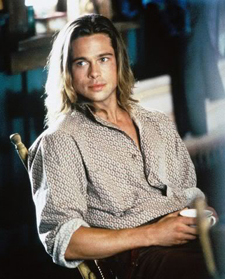 Take as an example Carl Plantinga’s paper on how we strike up moral attitudes toward characters. He was interested in how we achieve what Murray Smith calls “allegiance”—a “pro-attitude” toward certain characters. Is it just a matter of wishing good things for them, or admiring their positive traits? Is it a matter of sympathy for their situation?
Take as an example Carl Plantinga’s paper on how we strike up moral attitudes toward characters. He was interested in how we achieve what Murray Smith calls “allegiance”—a “pro-attitude” toward certain characters. Is it just a matter of wishing good things for them, or admiring their positive traits? Is it a matter of sympathy for their situation?
Carl argued that all these factors play a role, but they aren’t enough to assure our siding with a character. He argues that allegiance also involves moral judgments, or rather moral intuitions. Films exploit two facts about these moral intuitions: they must be summoned up quickly, without much thought, and they are often driven by emotion rather than ideas.
Oddly enough, our moral intuitions are not necessarily driven by moral standards! Carl drew on Anthony Appiah’s analysis of moral judgments as influenced by how a situation is framed, ordered, and primed—basic cognitive cues that influence responses. For example, Legends of the Fall sets up two brothers, one conventionally moral and the other not. Yet it’s the wild, violent Tristan who earns our sympathies, because he displays vitality, youth, beauty, sensitivity, and closeness to nature. The upshot is that we rationalize a moral judgment on non-moral grounds. Carl got several questions about his conception of morality and the possibility that our moral intuitions are tied to things we value, like beauty.
Malcolm Turvey offered a paper on gags in Jacques Tati. Pointing to prior work on how Tati’s gags are integrated into a shot’s composition (scattered so that we may miss them) and linked to one another (through overlap, Kristin has suggested), Malcolm went on to argue that the gags themselves don’t obey the conventions of classic comedy. They exhibit strategies of misinterpretation, blockage, ellipsis, fragmentation, and concealment that are highly original and unusually challenging. Malcolm is working on a book on “ludic modernism,” and he sees Tati as fitting into this tradition.
Malcolm’s precise and persuasive account was framed by a strong attack on the tendency of cognitive film theory to concentrate on ordinary, even undistinguished films and ignore problematic and avant-garde instances. He pointed to passages in Stephen Pinker’s writings that mock experimental art, and he urged cognitive film researchers to “call Pinker out” for his borderline Philistinism. He remarked that psychological researchers could learn as much from Tati’s work as from ordinary films…and maybe discover new things.
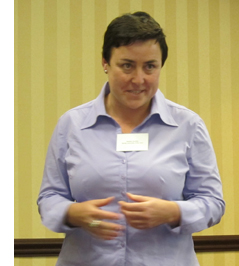 A similar sort of rational reconstruction at the level of personal response was found in many other papers I heard. Jason Gendler dissected the misleading narration in The Blue Gardenia. Rory Kelly wondered why viewers tend to forget the water-utility plotline at the start of Chinatown. James Fiumara considered why modern startle effects are comparatively rare in classic horror films. Torben Grodal isolated a group of “disgust-driven phobic films” (Taxi Driver, Blade Runner, Se7en) that sink so deeply into disgust that melancholy drives out empathy. Lennard Hojberg studied circular camera movements that express the dizziness of love as based on embodied vision.
A similar sort of rational reconstruction at the level of personal response was found in many other papers I heard. Jason Gendler dissected the misleading narration in The Blue Gardenia. Rory Kelly wondered why viewers tend to forget the water-utility plotline at the start of Chinatown. James Fiumara considered why modern startle effects are comparatively rare in classic horror films. Torben Grodal isolated a group of “disgust-driven phobic films” (Taxi Driver, Blade Runner, Se7en) that sink so deeply into disgust that melancholy drives out empathy. Lennard Hojberg studied circular camera movements that express the dizziness of love as based on embodied vision.
Some researchers used quantitative procedures to capture a film’s regularities. Monika Suckfuell (right) exposed some very complex patterns in a short film, Father and Daughter. These create a distinct emotional tone through what she calls “distance editing.” The patterns are combinations of thematic units like problem-solving or humor, and the recurring combinations arouse both comprehension and pleasure. In another quantitative study, Tseng Chiaoi and John Bateman sought to tie concrete uses of filmic elements with more abstract aspects of meaning. (Chiaoi and John had done a presentation on film-based discourse semantics at last year’s event.) Concentrating on characters’ action patterns, Chiaoi used computer software to trace their structures in television commercials and the war genre.
Squeezing the stimulus
Bopping after a session: Tseng Chiaoi and Paul Taberham.
The talks I’ve mentioned, along with several others, analyze processes that we can access by re-viewing films, studying their form and materials, and examining the genres and stylistic traditions to which they belong. But other talks concentrated on the subpersonal areas, the parts of our responses that we can’t access so easily.
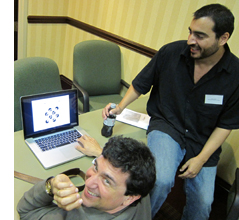 For instance, how do we mentally stitch together various shots to create a unified space for a scene’s action? Film scholar Todd Berliner and psychologist Dale Cohen presented an account of how we achieve an illusion of spatial continuity. Initially the brain grasps shots as if they were pieces of space selected by the viewer, and then it builds up a model of the whole space—say a porch in front of a house’s front door. When a character moves his arm a certain way toward an offscreen area, our model of porches and doors makes it most probable that he is pressing the doorbell.
For instance, how do we mentally stitch together various shots to create a unified space for a scene’s action? Film scholar Todd Berliner and psychologist Dale Cohen presented an account of how we achieve an illusion of spatial continuity. Initially the brain grasps shots as if they were pieces of space selected by the viewer, and then it builds up a model of the whole space—say a porch in front of a house’s front door. When a character moves his arm a certain way toward an offscreen area, our model of porches and doors makes it most probable that he is pressing the doorbell.
In such ways we run “beyond the information given.” Filmmakers count on our doing that, so they give us feedback (say, the sound of a doorbell, or a shot of a door opening) that confirms our model of the space. Most mainstream films build in such redundancy. But the unity of these spaces is undermined by some contemporary exhibition technology. Todd and Dale suggested that the mental models we build of space exclude the movie theatre, so that surround sound and 3D become problematic.
They also got several good questions. How concretely specified are these model spaces? How do they develop in the course of a scene? Might our perception of continuity come down to a lack of perception of discontinuity—that is, maybe we operate on very simple default assumptions and don’t build up many models of the space.
Todd and Dale’s presentation was in the Helmholtz tradition; they even invoked “unconscious inference” as part of the story. Another tradition, represented by SCSMI founders Joseph and Barbara Anderson, invokes James J. Gibson’s ecological approach to perception, which argues that such modeling and inference-making isn’t really happening. Things are much more direct: Perception is data-driven, and needs top-down correction only in rare cases (like nighttime or fog).
Other perceptual researchers try for a more parsimonious research strategy: How much information about the visual world can we squeeze out of the stimulus? This question was raised by Jordan DeLong, who has been exploring how we can identify emotional arousal through very “low-level” information. Using a corpus of 150 films (more on this later), he looked at shot lengths, the distribution of shot-lengths across a film, and a purely physical measure of visual activity (essentially the change from frame to frame) to see if they correlate with genres we associate with high levels of arousal, like action and adventure films. Jordan’s study is preliminary, but there is the possibility that certain purely physical features are reliable indices to levels of arousal—even if people don’t notice those features and are much more fastened on characters and their actions.
The current projects of Tim Smith’s research team exemplify the parsimonious strategy. Tim is a long-time participant in SCSMI, and his talks show how a research program can expand and enrich itself.
We know people look at certain areas of a shot. We also know that our attention is directed, driven by features of the stimulus. What features? We filmies would pick out shot composition, color, movement, lighting, shot scale, etc. We can access those middle-level variables through expert introspection and analysis. But can those features be further decomposed?
Tim thinks so. We can consider any of these technical qualities as made up of luminance, color channels, and other low-level physical aspects of vision. Through signal-detection methods, Tim seeks to pinpoint what the crucial variables are. The results of his work are soon to be published, and I don’t want to give the game away. I’ll just say that he has shown through eye-tracking that certain low-level features are more important than others in engaging viewers’ attention.
One implication of Tim’s findings is that what I’ve called “intensified continuity” seems to have an optimal grip on spectators. This technique, he remarked, “almost paralyzes the eyes,” yielding “an illusion of active vision with passive eyes.” More generally, his work seems to back up James Cutting’s remark that “There is no such thing as voluntary attention sustained for more than a few seconds at a time.” Most of our attention is at the mercy of the outside world, which means that filmmakers need to engage us at every moment—either with narrative, or with something else we’ll find arresting.
Dan Levin, Pia Tikka; in the background William Brown, Carl Plantinga, and Dirk Eitzen.
Dan Levin gave the keynote address at SCSMI two years ago, and he showed how we vastly overrate our ability to spot outrageous changes in the world or on the movie screen. (He’ll have a field day with the tricks in Shutter Island, such as the one surmounting this blog.) This time around Dan talked about Theory of Mind in the movies, the ways that films exploit our (species-specific?) inclination to attribute beliefs, desires, and goals to the creatures we see in the world, and in films. His paper scanned mandatory, bottom-up cues, middle-level activity (the sort of organization of visual space Todd and Dale discussed), and then “controlled cognition,” such as our narrative expectations. So for Dan it’s not all in the stimulus. Once we’ve picked out certain aspects of it, our Theory of Mind system locks on them.
What aspects? Chiefly, signals of intention and marked eye direction. When we think we’re watching an intentional agent, like a movie character, we tend to see the agent’s eye direction as giving us a clue to his or her aims. Using films he has made, Dan tests people for how eyeline-matched cuts are read, and he varies the cues to see how people construe them differently.
Interestingly, when he showed the same shots in a different order, about two-thirds of the subjects didn’t notice that the order was different. That is, whether the object of the glance or the person glancing came first, gaze deflection remained the primary cue to understanding the situation. This suggests to me that storytelling cinema doesn’t absolutely need the classic pattern of person looking/ person looked at/ person looking, but the extra shot makes sure we all understand (redundancy again).
A similar sort of top-down/ bottom-up theory was proposed by Dan Barratt, who gave it a more computational spin. Like Tim, he works on eye movements; like Todd and Dale he’s interested in how we construct space; like Dan, he seeks out intentional factors. It’s not all in the stimulus, but we won’t know how much until we keep squeezing.
Ripples in the flow of films
The Society broke new ground in what I called the “suprapersonal” realm, that of large-scale patterns of activity that aren’t explicitly coordinated by individuals or groups. Several researchers are probing this in relation to films. Films are, in effect, deposits of human behavior; they are artifacts resulting from choice. What if we find patterns of choice that we can’t plausibly trace to coordinated decision-making?
Chris Atherton raised the issue by considering how to study style statistically. Citing Barry Salt as a pioneer in the area, he focused on the work of the Cinemetrics group and offered suggestions on how to better collect data and track patterns at various levels of generality. More sharply, he posed the question of function. How can you measure that? One implication was that in a big body of films we can disclose order that can’t wholly be explained as the sum of individual choices. Those choices matter, but so do forces we have yet to determine, including historical processes. Chris’s reflections chimed nicely with those of our keynote speaker.
James E. Cutting is a distinguished perceptual psychologist at Cornell. He’s written a fine book on motion perception and has done a quantitative historical study of the creation of the canon of French Impressionist painting. He’s a former dancer and a sensitive appreciator of art and music (and film). He’s the ideal person to analyze ticklish aesthetic issues.
You may have run across him recently because his research on Hollywood films was picked up and trumpeted in the press. “Solved: The Mathematics of the Hollywood Blockbuster,” read one headline. Needless to say, James was doing something more subtle. You can read summaries here and here.
In his lively address, “Attention, Intensity, and the Evolution of Hollywood Film,” James explained two of his areas of interest: the ebb and flow of change across a film, and how that change is tied to human pickup. James studies these topics with a big database: 150 movies from 1935 to 2005. He emphasizes widely seen films belonging to five genres and chosen from the highest-rated titles on IMDB. But there’s a micro- side too. He and his research team went through every film frame by frame coding each one along many dimensions.
Naturally, he takes on the vexed issue of Average Shot Length. You can read the ongoing discussions of this concept on Yuri Tsivian’s Cinemetrics site. What interests James is less ASL in itself than the ways in which comparable patterns of shot lengths cluster in certain parts of the film. A film’s ASL may be 8 seconds, but in some passages several shots might have similar lengths, say 12 seconds each. Moreover, those patterns may “ripple through the film,” recurring at certain intervals and different scales (shot clusters, scenes, or other chunks).
 Not every film shows such patterns; film noirs seem random in their patterns of shot lengths. But many movies, especially those of the last fifty years do display these patterns—typically clusters of short shots for physical action, clusters of longer ones for conversations. This clustering tendency is on the increase, even outside the action genre.
Not every film shows such patterns; film noirs seem random in their patterns of shot lengths. But many movies, especially those of the last fifty years do display these patterns—typically clusters of short shots for physical action, clusters of longer ones for conversations. This clustering tendency is on the increase, even outside the action genre.
The finding leads James to ask about the pacing of visual change, which raises the prospect of the sort of tension/ release dynamics we find in music. The patterns he finds don’t look arbitrary because they match the so-called 1/f or pink-noise pattern. This pattern has been detected in the natural world, in heartbeats, and in brain activity. It’s also been discovered in reaction times to tasks. In effect, the 1/f pattern captures not continual attentiveness but rather an alternation of intense concentration, moments of slower pickup, and moments of sheer mind-wandering. A nontechnical explanation of the 1/f pattern is here; a technical one is here.
As for intensity, James is seeking to measure visual activity in the shots. How much change, in effect, can there be from frame to frame? This can be captured by correlating each frame with its mates. James and his team find that from 1930 to 1950, there’s been a steady increase of frame-to-frame visual activity across all genres. The images became busier, with more movement. Today, he suggests, Hollywood is exploring ways to raise the frame-to-frame visual activity—not only through lots of movement of characters (the action film comes to mind) but also through “queasicam” handheld movements.
In combination with decreasing ASLs, Hollywood seems to be asking: How briefly can I show you this and still get the point across? So far, James suggests, films like Mission: Impossible III and The Bourne Ultimatum seem to be the busiest at the visual level. But animated films score about the same.
James has a caveat: The size of the screen matters. Even a big home-theatre screen doesn’t duplicate the breadth of a theatre screen, which activates not only our central vision but our peripheral vision too. That’s why bumpy shots that you can tolerate on a computer monitor may make you queasy at the multiplex. Interestingly, the Bourne films and Cloverfield, James suggests, were more popular on IMDB after the DVD versions came out. Perhaps people were better able to assimilate them on a smaller display.
At one level, James is interested in the subpersonal factors. He grants that you don’t notice cuts but can attend to them if you shift your focus from the story. But the widespread patterns he discloses aren’t easy to ascribe to deliberate planning. Nobody but an avant-gardist would decide to have shots of similar lengths at points 14 minutes or 25 minutes apart throughout the film. But James finds such correlations at levels beyond chance.
I can’t pretend to understand everything mathematical in James’ argument, but I think that his discoveries open up a new way to think about pacing in film. My first impulse is to think about historical causes, as Chris suggests: filmmakers learning from each other, converging on optimum choices. But I also like to entertain the possibility that this optimum carries a resonance even beyond the flux of history. Perhaps like fish and fowl, filmmakers are obeying and viewers are fulfilling, completely unawares, deep rhythms built into nature and numbers.
A tangled databank
Traditional humanists would decry a lot of what goes on at SCSMI meetings. The appeal to general explanations, the recourse to biology and evolution, the use of quantitative and experimental methods would all smack of “scientism.” But more and more, humanists are starting to turn away from the endless reinterpretation of canonical or non-canonical artworks. Many are also quietly defecting from the Big Theory that dominated the 80s and 90s. In film publishing, I’m told, editors have come to an informal moratorium on books on Deleuze. Possibly more people write them than read them.
Committed to a theory of permanent revolution in Theory, humanists are seeking new pastures. Some have discovered neuroscience, others evolutionary psychology. Franco Moretti has launched quantitative studies of the literary marketplace. For many converts, the reconciliation with science is just a bandwagon to hop onto, and they will jump off when a newer one trundles past. But other scholars have been committed from early on. The prospect of “consilience,” the compatibility between the sciences and the arts, is something the literary Darwinists like Brian Boyd, Jonathan Gottschall, Joseph Carroll, and like-minded souls were defending long before it became fashionable.
Film theory, as Joe Anderson is fond of pointing out, has a long and intense fascination with experimental psychology. Hugo Münsterberg, Rudolf Arnheim, and Sergei Eisenstein saw no conflict in studying film art with tools and findings derived from the sciences. That interest was lost in the 1960s, for a variety of reasons. But some of us have persisted. An explicitly “cognitive” perspective has been developing in film studies for the last twenty-five years, and SCSMI has nurtured this tradition since 1997. Our commitment is deep. We’re making headway. We’re not going to go away.
There is grandeur in this view of life, and cinema.
Our Society owes a great debt to Stephen Prince of the Virginia Tech School of Performing Arts and Cinema, who hosted this year’s convention. He also gave a splendid paper on the research traditions behind precinematic optical toys, as a way of thinking about modern CGI.
I found these books on suprapersonal patterns helpful: Mark Buchanan, The Social Atom: Why the Rich Get Richer, Cheats Get Caught and Your Neighbor Usually Looks Like You (London: Cyan, 2007); Steven Strogatz, Synch: The Emerging Science of Spontaneous Order (New York: Theia, 2003); Philip Ball, Critical Mass: How One Thing Leads to Another (New York: Farrar Straus Giroux, 2004).
Todd Berliner and Dale Cohen’s paper, “The Illusion of Continuity: Active Perception and the Classical Editing System,” is scheduled for publication in the Journal of Film and Video in 2011. Tim Smith’s paper is in press at Cognitive Computation as P. J. Mital, T. J. Smith, R. Hill, and J. M. Henderson, “Clustering of gaze during dynamic scene viewing is predicted by motion.” You can check Tim’s DIEM project for video demonstrations, and his blog, Continuity Boy.
The original article by James Cutting, Jordan DeLong, and Christine Nothelfer, “Attention and the Evolution of Hollywood Film,” appeared in the March issue of Psychological Science. Access is through subscription.
As for Shutter Island, thanks to Justin Daering for pointing out the double sleight-of-hand. More thoughts on the film and Scorsese’s expressionist/ impressionist tendencies are in our backfile.
1999 Conference of the Center [later Society] for Cognitive Studies of the Moving Image; Valby, Denmark. Photo by Johannes Riis.
The Cross
The Puffy Chair (2005).
Mark: [The actors] need to improvise. They need to find the moments, and we don’t let them lean on the script too much. We want them to try to reinvent some of the dialogue and make it fresh.
Jay: We don’t do any blocking. Our whole goal is just to set up a room and basically foster an interaction that we feel is interesting and real.
Mark: And spontaneous.
Jay: And spontaneous.
Jay and Mark Duplass, talking of their new film Cyrus.
DB here:
We don’t do any blocking. Dude, we noticed. In The Puffy Chair, the Duplass brothers typically settle the actors into one spot and pan or cut between them.
Seldom do the characters move around the setting. When they do, it’s usually by means of a walk-and-talk traveling shot that transitions to the next static layout of actors.
We are talking about filmmakers who refuse the challenge of staging.
At the other extreme of budget and commercial clout, consider another film by two brothers. In The Matrix Reloaded, Neo meets the Oracle in the virtual courtyard and sits on a bench with her.
The whole scene, which runs nearly seven minutes, contains 94 remarkably static shots. After Neo settles on the bench beside her, we get simple reverse shots—lots of them, mostly one per line of dialogue. The setups are maniacally repeated. There are thirty-one iterations of the first framing below and eighteen of the second.
The only variation is a slightly tighter framing on each character, creating another brace of single setups during Neo’s acknowledgement of his dream of Trinity’s death. Each of these gets nine iterations.
Sustained two-shots would have let the actors do more with their upper bodies, but in this string of singles, faces and dialogue have to present Neo’s reactions to his new mission to save Zion. Granted, there are seven shots showing both Neo and the Oracle in the same frame, but these are very brief and seem to be there simply to provide beats and add some variety to the load of exposition the scene must carry.
Breaking the scene up so much has interesting rhythmic implications. Paradoxically, our movies are cut very fast but they feel rather slow (and run very long). When we need a cut to see a character’s reaction, a scene plays out more slowly than if the characters were held in the same frame for a significant period. Then we might see Neo’s reactions while the Oracle is speaking, rather than having to wait for them afterward.
But my main point is that the actors are planted in one spot. Like the Duplasses, the Wachowski brothers have felt no need to imagine the characters’ interaction through blocking. Indeed, when shooting a conversation, most of today’s filmmakers seem happiest if the actors stay riveted in place—standing, seated, riding in a car, typing at a computer terminal. Improvised cinema or storyboard cinema: Both camps are refusing the challenge of staging.
In some books and some web entries (most recently, here and here and here and here), I’ve tried to trace the rich tradition of ensemble staging. From almost the start of cinema, filmmakers have explored creative ways of moving actors around the set, aiming at both engaging storytelling and pictorial impact. Since the 1960s, on the whole, this tradition has been waning. Now, I fear, it has nearly disappeared.
I’m not going to reiterate those earlier arguments. Instead I want to talk about one simple staging tactic that directors almost never employ today. I offer it at no cost to young directors. Try it! You might get a taste for a range of cinematic expression that is nowadays neglected.
Cross and double cross
Assume you have two characters in a set. At a crucial moment, you invent some business that lets them exchange places, so that the one on the left winds up on the right, and vice-versa. At a minimum, this gives you visual variety; it keeps the viewer’s attention engaged by refreshing the composition. It can of course also heighten dramatic impact.
Naturally, we expect to find the Cross in the first golden age of cinematic staging, the 1910s. Here’s a case that combines the cross with depth staging, from the Doug Fairbanks picture The Matrimaniac (1916).
Marna and the Court officer have switched places in the frame. Note especially that her movement to the right, clearing our view of the officer at the door, is motivated by her hesitation at following him. Actually such moments probably don’t need much motivation; the flow of the action is so quick that no viewer will ask why she moved to the right, since our attention is on what her action reveals.
One way to motivate the Cross is to have A turn sharply away from B but keep talking. This is a bit of actor’s business that seems far more common in the classical era of moviemaking. Here is an excerpt from a single-shot scene in Budd Boetticher’s The Tall T (1957). Brennan tries to console Mrs. Mrs. Mims, who has realized that her husband betrayed her. He enters the shack and then walks past her, as if considering exactly how to calm her.
This has been the prelude to a more intense confrontation. She comes closer to the camera, and Brennan joins her, forcing her to look at him as he says they must concentrate on staying alive.
In Demy’s Lola (1961) the Cross is motivated by the urge to offer another emphatic view of the protagonist. Roland has been talking to the two mother-figures who run the café he frequents. He’s dragging himself off to work as Jeanne fetches her radio from the bar and goes into the back room. We get two Crosses.
The shot’s climax comes when Roland pauses in the foreground and says: “One day I’ll go away too.” Again, a key character is turned from the other but continues to speak.
No need to cut in to a close-up because Roland’s face is perfectly visible. Just as important, while his face shows a certain reverie, his nervousness is conveyed by the way he waggles the novel in his hand. The actor is given a chance to act, not just with line reading and facial expression but with his slumped posture and his arms—one casual, the other in anxious motion. Taken together, the body and the face present Roland’s confusion.
Crossfire
Don Siegel’s The Big Steal (1949) yields many offhand instances of the Cross, indicating how taken for granted the technique was in studio films. When the slippery Fiske invites Joan in, she comes to the left foreground and he moves to the right side of the frame to shut the door.
Approaching her by stepping into medium shot, he tries to warm her up, but she slaps him. Cut in to underscore her reaction. “What did you expect—kisses?”
In a return to the earlier setup, she turns away and executes another Cross, settling on the sofa.
Simple and concise; some would say banal. But compared to The Puffy Chair and The Matrix Reloaded, it looks brisk. The characters move easily through the frame without camera arabesques, and the medium shot is saved for the slap. The single of Joan adds another spike to the drama. Close-ups no longer rule but are used for momentary emphasis.
So the Cross can be sustained by cutting and camera movement. In The Lady Is Willing, Liza has found a baby and called a pediatrician. Director Mitchell Leisen gives us an over-the-shoulder shot of her and at the close of it she walks around Dr. McBain’s arm, with her feathery hat brushing his face.
If the shot were sustained with a pan, we’d have a Cross, but instead there’s a cut to Liza continuing the movement. McBain turns to watch her.
He starts to follow her diagonally. When she pauses to face him, the Cross is completed.
They leave the room. After a cutaway shot showing Liza’s secretary, the camera pans to follow McBain into depth washing his hands. When he comes through the door past Liza, we get another Cross.
With positions switched, the camera travels with her as she catches up with him in a medium shot. He is opening his medical bag.
This pause enables Leisen to underscore a key line of dialogue. “I detest children of all ages. I detest infants particularly.”
One more Cross and the shot is done. The camera pans again to follow McBain bending over the child, and Liza slips into the shot behind him, remonstrating with him. “A man who dislikes children simply can’t be a baby specialist.”
As so often, the Cross is used to present one character turning from another, or one trying to catch up with another who for dramatic reasons plows ahead. And the Cross favors a moderate depth, not the eye-smiting foregrounds of Welles but something less aggressive. In these ways, the simple device can participate in a broader pattern of fluid craftsmanship. The action can unfold in a clean rhythm, consistent with what Charles Barr calls “gradation of emphasis.” Story points arise smoothly out of the flow of behavior. Actors get a chance to use their whole bodies, to create character through posture or stance, or even the angle of the elbows. Imagine if Dietrich, in the left shot just above, had sauntered to McBain with her hand on her hip as she does in so many other movies; the scene would take on a different tint.
When thinking about staging, we usually invoke Renoir or Ophuls or Jancsó, directors who integrate complex choreography with complicated tracking shots. (They also use the Cross a lot.) My examples try to show that even simple camerawork can enhance the performers’ grace. Nor do they have to execute the calisthenics on display in the office scenes of His Girl Friday. The modest moves we see in The Big Steal and The Lady Is Willing are within the grasp of eager filmmakers and game actors.
Cross purposes
I don’t have a good explanation for why such simple staging tactics have gone out of fashion. It’s too easy to cite laziness or lack of imagination, though they may play a role. I wonder as well if complicated staging is much taught in film schools. More specifically, improvisational methods may actually inhibit creative blocking. An actor who’s winging it may be reluctant to shift around the set, for fear that this creates new problems for framing or lighting or the other performances. Better, the actor may think, to concentrate on line readings, expressions, and other things that she can control while staying rooted to the spot. And maybe our directors don’t want to work their actors too hard, especially when the actors are beginners or nonprofessionals, as we find in indie filmmaking. Yet some masters of supple, intricate staging, such as Hou Hsiao-hsien, employ untrained performers.
Contemporary directors may have a more principled objection to the older staging style: It’s too artificial. In real life, people mostly chat with each other when they’re sitting down, or walking, or riding in a car. Static staging, some might say, captures the passive nature of everyday interactions.
But dramatic narrative typically doesn’t consist of ordinary life. A film offers heightened, focused, pointed encounters, shot through with meaning and feeling. The actors and the filmmaker have a chance to sharpen the viewer’s perception of the situation and pass along the moment-by-moment play of thought, emotion, and action. There are both loud and quiet ways of doing this. Antonioni’s famously “dedramatized” scenes are staged as dynamically as the more florid moments of Visconti or Fellini. Emotionally subdued action can be shaped just as precisely as passionate outbursts, and it can carry its own impact.
I should make it clear that I’m not asking anybody to embrace a single style. Sometimes stand-and-deliver and intensified continuity editing work very well. Directors will always seek specific solutions to the problems of a scene. But I don’t see much variety in the solutions many people now pursue. I don’t see evidence that most young filmmakers around the world are aware that traditions furnish lots of alternatives.
In earlier periods, some directors were as editing-oriented as today’s mainstream ones, while other directors adopted more staging-driven approaches. But either sort had a broader palette than what we see today. Any accomplished director could stage a conversation in a variety of ways. Just to take Demy, some scenes in Lola are handled in full shots like the one highlighting Roland in the café. Other scenes are broken up into tight singles, and still others are treated in two-shots.
All the classical films I’ve mentioned are pluralistic in their technical choices. Today, though, we see more uniformity, or rather conformity.
Cinephile conversation on the internet is currently rippling around a controversy about “slow cinema.” Whatever that rough category covers, it surely includes those festival films that put the camera in one spot per scene and simply observe. I’d argue that many of these minimalist movies are also AWOL when it comes to staging. After watching a long-take, flatly shot film with me, a Hong Kong filmmaker friend remarked, “This sort of thing is just too easy.” One difference between a solid “slow film” and an empty one, I suspect, lies in the extent to which the filmmakers explore the resources of staging. How do we know? We have to analyze the films. (More on this matter here.) Absent that analysis, critics’ appeals to realism or meditative restfulness or “time flowing through the shot” risk becoming alibis for inert moviemaking.
Many young directors want to be innovative. They want to shake things up. This is a good impulse. The way things are going, the ambitious way forward is obvious: Go backward. Avoid stand-and-deliver. Avoid walk-and-talk. Get your actors on their feet and move them around the setting. Invent bits of business that let them crisscross the frame, laterally and in depth. Dynamize all areas of the shot. In the process you may discover new dimensions of creativity.
The Cross is only one tactic, but I think it’s useful as a way to sensitize ourselves to staging. The best way to understand staging is to watch, really watch, a lot of classic cinema from Hollywood and elsewhere. When you’re ready for the hard stuff, Mizoguchi is waiting.
I expect disagreements with my criticisms of contemporary film technique, so I hope skeptics will consider my more extensive arguments in On the History of Film Style, Figures Traced in Light, and The Way Hollywood Tells It.
I haven’t found references to what I call the Cross in manuals of direction. The closest technique, and the one that called my attention to the possibilities of the technique, is what Mike Crisp in his valuable book The Practical Director (first ed., 1993) calls the “rise and cross.” This refers to actors getting up from sit-down conversations in one spot and moving to another sit-down area, while switching position in the frame. I’ve expanded the idea to cover a broader variety of situations.
As far as I can tell, my term doesn’t have much in common with the stage direction “Cross,” which you’ll find in play scripts. Janie Jones provides definitions here. While staging in film is in many respects different from that in theatre, I think that moviemakers can find intriguing practical ideas in Terry John Converse, Directing for the Stage.
Alicia Van Couvering’s interview with the Duplass brothers, “Don’t you want me?”, is published in Filmmaker 18, 3 (Spring 2010; not yet available online); my quotation is from p. 43. In his essay Slow Cinema Backlash, Vadim Rizov argues that lesser attempts at “slow cinema” have led to a somewhat predictable style.
Raining in the Mountain (King Hu, 1979).












